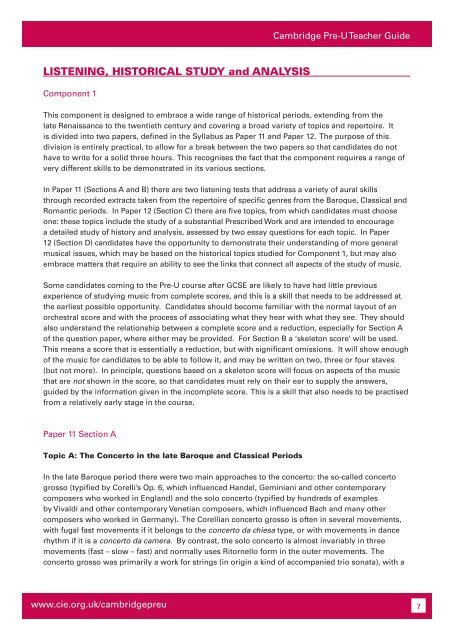Teacher's Guide Cambridge Pre-U MUSIC Available for teaching ...
Teacher's Guide Cambridge Pre-U MUSIC Available for teaching ...
Teacher's Guide Cambridge Pre-U MUSIC Available for teaching ...
You also want an ePaper? Increase the reach of your titles
YUMPU automatically turns print PDFs into web optimized ePapers that Google loves.
LISTENING, HISTORICAL STUDY and ANALYSIS<br />
Component 1<br />
<strong>Cambridge</strong> <strong>Pre</strong>-U Teacher <strong>Guide</strong><br />
This component is designed to embrace a wide range of historical periods, extending from the<br />
late Renaissance to the twentieth century and covering a broad variety of topics and repertoire. It<br />
is divided into two papers, defined in the Syllabus as Paper 11 and Paper 12. The purpose of this<br />
division is entirely practical, to allow <strong>for</strong> a break between the two papers so that candidates do not<br />
have to write <strong>for</strong> a solid three hours. This recognises the fact that the component requires a range of<br />
very different skills to be demonstrated in its various sections.<br />
In Paper 11 (Sections A and B) there are two listening tests that address a variety of aural skills<br />
through recorded extracts taken from the repertoire of specific genres from the Baroque, Classical and<br />
Romantic periods. In Paper 12 (Section C) there are five topics, from which candidates must choose<br />
one: these topics include the study of a substantial <strong>Pre</strong>scribed Work and are intended to encourage<br />
a detailed study of history and analysis, assessed by two essay questions <strong>for</strong> each topic. In Paper<br />
12 (Section D) candidates have the opportunity to demonstrate their understanding of more general<br />
musical issues, which may be based on the historical topics studied <strong>for</strong> Component 1, but may also<br />
embrace matters that require an ability to see the links that connect all aspects of the study of music.<br />
Some candidates coming to the <strong>Pre</strong>-U course after GCSE are likely to have had little previous<br />
experience of studying music from complete scores, and this is a skill that needs to be addressed at<br />
the earliest possible opportunity. Candidates should become familiar with the normal layout of an<br />
orchestral score and with the process of associating what they hear with what they see. They should<br />
also understand the relationship between a complete score and a reduction, especially <strong>for</strong> Section A<br />
of the question paper, where either may be provided. For Section B a ‘skeleton score’ will be used.<br />
This means a score that is essentially a reduction, but with significant omissions. It will show enough<br />
of the music <strong>for</strong> candidates to be able to follow it, and may be written on two, three or four staves<br />
(but not more). In principle, questions based on a skeleton score will focus on aspects of the music<br />
that are not shown in the score, so that candidates must rely on their ear to supply the answers,<br />
guided by the in<strong>for</strong>mation given in the incomplete score. This is a skill that also needs to be practised<br />
from a relatively early stage in the course.<br />
Paper 11 Section A<br />
Topic A: The Concerto in the late Baroque and Classical Periods<br />
In the late Baroque period there were two main approaches to the concerto: the so-called concerto<br />
grosso (typified by Corelli’s Op. 6, which influenced Handel, Geminiani and other contemporary<br />
composers who worked in England) and the solo concerto (typified by hundreds of examples<br />
by Vivaldi and other contemporary Venetian composers, which influenced Bach and many other<br />
composers who worked in Germany). The Corellian concerto grosso is often in several movements,<br />
with fugal fast movements if it belongs to the concerto da chiesa type, or with movements in dance<br />
rhythm if it is a concerto da camera. By contrast, the solo concerto is almost invariably in three<br />
movements (fast – slow – fast) and normally uses Ritornello <strong>for</strong>m in the outer movements. The<br />
concerto grosso was primarily a work <strong>for</strong> strings (in origin a kind of accompanied trio sonata), with a<br />
www.cie.org.uk/cambridgepreu 7
















